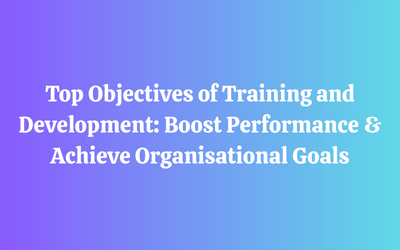Strategic training is a structured approach to workforce development that aligns employee learning with an organization’s long-term business objectives. Unlike traditional training methods, strategic training focuses on preparing employees for evolving job roles, bridging skill gaps, and maintaining a competitive edge in the market. Businesses that integrate a well-defined strategic training process into their operations can enhance employee productivity, improve job performance, and drive organizational performance.
This guide explores strategic training, its frameworks, and how businesses can implement it effectively.
What Is Strategic Training?
Strategic training refers to training initiatives that support business strategies, ensuring that employees develop skills aligned with the company’s organizational goals and future needs. It incorporates continuous learning, capability gaps analysis, and competency-building programs to prepare employees for dynamic business conditions.
Unlike general training programs, strategic training takes into account:
- Business alignment: Ensuring that training activities are directly linked to strategic objectives.
- Employee motivation: Creating engagement through targeted learning initiatives.
- Competitive strategies: Enhancing the organization’s ability to adapt to changing market demands.
- Skill shortages: Addressing workforce deficiencies through reskilling and upskilling.
Frameworks for Strategic Training
Organizations can adopt different frameworks to implement an effective training program. Here are some widely used models:
1. The 5P Model for Strategic Training
This model outlines the essential key components of strategic training:
- Philosophy: Defines the organization’s approach to training and learning culture.
- Policies: Establishes rules for training activities, such as training evaluation and transfer of training.
- Programs: Includes training initiatives such as leadership development and sensitivity training.
- Practices: Determines how training is delivered (e.g., traditional training methods vs. online learning).
- People: Focuses on the learners, including new hires, current employees, and leaders.
2. The Action Research Model
This model emphasizes continuous improvement in training and consists of:
- Identifying organizational challenges and workforce gaps.
- Designing training programs based on real-time business operations needs.
- Implementing job-related competencies training.
- Analyzing outcomes and refining training strategies.
3. The STEM Model
The STEM model (Strategic Training for Employee Management) focuses on integrating training into broader Strategic Human Resource Management efforts. It emphasizes:
- Human Resource Planning for future workforce needs.
- Career development models to support long-term growth.
- Supply chain management for skill distribution within teams.
4. The Business-Embedded Model
This approach integrates training & development into everyday business activities, ensuring that organizational characteristics like culture and leadership are part of the strategic training process.
Steps in the Strategic Training and Development Process
1. Strategic Planning for Training
The first step is to align training initiatives with the company’s business plans and strategic goals. This requires:
- Assessing external factors such as market trends and industry shifts.
- Identifying internal factors like workforce capabilities and forecasting employee needs.
- Establishing a strategic plan that connects training to broader management development goals.
2. Identifying Skill Gaps and Employee Needs
Organizations must evaluate workforce skills to identify capability gaps and job-related competencies. Methods include:
- Performance appraisal and feedback.
- Business-embedded model assessments.
- Reviewing organizational characteristics to align with employee learning styles.
3. Designing and Delivering Training Programs
Once skill shortages are identified, businesses can implement development programs that focus on:
- Soft skills training (communication, leadership).
- Technical skills development (industry-specific training).
- Employee stock ownership plans and financial literacy for long-term engagement.
4. Training Evaluation and Performance Tracking
Measuring training effectiveness is critical. The transfer of training concept ensures that employees apply learned skills in the workplace. Common evaluation methods include:
- Analyzing learner progress through KPIs.
- Reviewing employee engagement and feedback.
- Assessing organizational capability improvements.
Examples of Strategic Training Programs
1. Leadership Development Programs
A well-structured leadership program can enhance management development and create future-ready leaders. It includes:
- Career management process workshops.
- Coaching sessions for strategic management accounting skills.
- Real-world decision-making scenarios.
2. Cross-Skilling and Employee Development
Cross-training employees strengthens the workforce by allowing them to develop multiple skills. Benefits include:
- Reduced shortage of employees in critical areas.
- Increased adaptability in business strategies.
- Enhanced competitive edge through diversified skill sets.
3. Digital and Micro-Organizational Training
Businesses operating in dynamic industries benefit from micro-organizational training levels, which focus on:
- Short, intensive training sessions to improve efficiency.
- Continuous learning opportunities via e-learning platforms.
- On-the-job job learning experiences for real-time application.
4. Sensitivity and Diversity Training
To foster an inclusive workplace, businesses implement sensitivity training focusing on:
- Cultural awareness and organizational capability improvements.
- Training employees to handle individual challenges and family roles effectively.
- Strengthening country roles within international organizations.
The Role of Strategic Training in Business Success
1. Enhancing Employee Productivity and Engagement
A strategic training approach ensures that employees develop relevant skills, leading to:
- Higher job satisfaction.
- Increased workplace efficiency.
- Stronger alignment with business objectives.
2. Supporting Business Adaptability
Businesses that integrate training strategic plans remain resilient by:
- Adapting to business environment changes.
- Aligning business unit strategies with evolving industry needs.
- Utilizing business models that support continuous workforce development.
3. Driving Long-Term Business Success
By implementing strategic training initiatives, organizations can:
- Develop a highly skilled, adaptable workforce.
- Align training department efforts with corporate growth.
- Address environmental challenges and skill shortages effectively.
Final Thoughts
Strategic training is more than just a training session; it is a development process that fosters long-term growth. By using structured frameworks like the STEM model or the business-embedded model, businesses can implement effective training programs that prepare employees for future challenges.
Investing in Training & Development strengthens workforce competencies, ensures business alignment, and maintains a competitive edge. Organizations that prioritize strategic training initiatives are better positioned to navigate industry shifts and achieve long-term success.
Are You Ready to Implement a Strategic Training Plan?
Take action today to develop training activities that align with your company’s organizational goals and drive business success.
Learn More
Our News
- AI
- Animations
- Articulate
- Articulate 360
- Articulate Engage
- Articulate Live
- Articulate Presenter
- Articulate Quizmaker
- Articulate Replay
- Articulate Review
- Articulate Storyline
- Articulate Storyline 3
- Articulate Studio
- bite sized learning
- Characters
- Content Library
- Corporate Communication
- E-Learning
- e-Learning Authoring Tools
- Employee Engagement
- Game-Based Learning
- Gamification
- Gamiflexer
- Go Sales
- Healthcare
- Instructional Design
- Interactivity
- Knowledge Transfer
- L&D Trends
- Learning
- Learning & Development
- Learning Experience platform
- Learning Management System
- LMS
- LXP
- Microlearning
- mLearning
- Mobile Learning
- Nugget Learning
- Online Training
- Peek
- Performance Support
- Preso
- Quiz and Assessment Platform
- Replay 360
- Rise
- SCORM
- Screen Capture
- Software
- Storyline 360
- Studio 360
- Training Management
- Trainings
- Uncategorized




